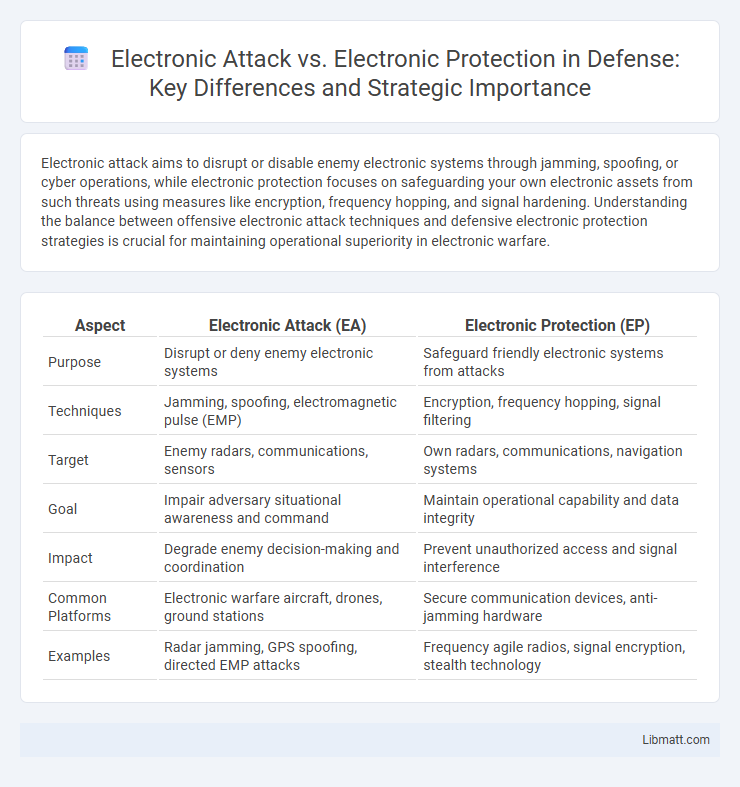Electronic attack aims to disrupt or disable enemy electronic systems through jamming, spoofing, or cyber operations, while electronic protection focuses on safeguarding your own electronic assets from such threats using measures like encryption, frequency hopping, and signal hardening. Understanding the balance between offensive electronic attack techniques and defensive electronic protection strategies is crucial for maintaining operational superiority in electronic warfare.
Table of Comparison
| Aspect | Electronic Attack (EA) | Electronic Protection (EP) |
|---|---|---|
| Purpose | Disrupt or deny enemy electronic systems | Safeguard friendly electronic systems from attacks |
| Techniques | Jamming, spoofing, electromagnetic pulse (EMP) | Encryption, frequency hopping, signal filtering |
| Target | Enemy radars, communications, sensors | Own radars, communications, navigation systems |
| Goal | Impair adversary situational awareness and command | Maintain operational capability and data integrity |
| Impact | Degrade enemy decision-making and coordination | Prevent unauthorized access and signal interference |
| Common Platforms | Electronic warfare aircraft, drones, ground stations | Secure communication devices, anti-jamming hardware |
| Examples | Radar jamming, GPS spoofing, directed EMP attacks | Frequency agile radios, signal encryption, stealth technology |
Understanding Electronic Attack and Electronic Protection
Electronic attack involves the use of jamming, deception, or cyber techniques to disrupt or disable enemy communication and radar systems, targeting vulnerabilities within electromagnetic spectrum operations. Electronic protection encompasses methods such as frequency hopping, encryption, and signal masking to safeguard your own systems from detection, interference, or exploitation by adversaries. Understanding these dynamics is essential for maintaining operational advantage and ensuring mission success in contested electromagnetic environments.
Key Concepts in Electronic Warfare
Electronic attack (EA) involves the use of electromagnetic energy or anti-radiation weapons to degrade, disrupt, or destroy enemy electronic systems, targeting radar, communications, and sensors. Electronic protection (EP) encompasses techniques and technologies designed to safeguard friendly systems from electronic attack, including frequency hopping, signal encryption, and emission control. Key concepts in electronic warfare balance the offensive capabilities of EA with the defensive measures of EP to maintain electromagnetic spectrum dominance.
Types of Electronic Attacks
Electronic attacks encompass a range of tactics including jamming, which disrupts communication signals by overwhelming frequencies, and spoofing, where attackers mimic legitimate signals to deceive receivers. Cyber-electronic attacks involve malware and hacking techniques targeting electronic systems to degrade or manipulate their function. Directed energy weapons, such as high-power microwaves, can disable or destroy electronic equipment, distinguishing them as a physical form of electronic attack.
Primary Methods of Electronic Protection
Primary methods of electronic protection include frequency hopping, spread spectrum techniques, and adaptive filtering to counteract electronic attacks such as jamming and signal interception. These methods enhance signal integrity by dynamically changing transmission parameters and filtering out malicious interference. Effective electronic protection relies on continuous signal monitoring and employing encryption to secure communications against electronic warfare threats.
Technologies Enabling Electronic Attack
Technologies enabling electronic attack include advanced jamming systems, cyber warfare tools, and directed energy weapons designed to disrupt or disable enemy electronic devices and communication networks. These systems leverage electromagnetic spectrum dominance, signal intelligence, and software-defined radios to exploit vulnerabilities in target electronics. Your understanding of these technologies is crucial for developing robust electronic protection measures that safeguard critical assets from sophisticated electronic attacks.
Advanced Protective Countermeasures
Advanced protective countermeasures in electronic protection involve sophisticated techniques such as frequency hopping, signal encryption, and adaptive jamming resistance to safeguard communication systems against electronic attacks. These measures enhance the resilience of your electronic infrastructure by detecting and neutralizing hostile signals before they can disrupt operations. Implementing cutting-edge electronic protection ensures continuous, secure functionality in complex electromagnetic environments.
Electronic Attack vs Electronic Protection: Core Differences
Electronic Attack (EA) involves the deliberate use of electromagnetic energy to disrupt, disable, or destroy enemy electronic systems, focusing on jamming, spoofing, and electromagnetic pulses. Electronic Protection (EP) encompasses techniques and technologies designed to safeguard friendly electronic systems from these hostile actions, using methods such as frequency hopping, signal encryption, and radar evasion. The core difference lies in EA targeting vulnerabilities to degrade adversary capabilities, while EP prioritizes resilience and countermeasures to maintain electronic system integrity.
Challenges in Modern Electromagnetic Environments
Modern electromagnetic environments present significant challenges for electronic attack and electronic protection systems due to increasing signal complexity and spectrum congestion. Electronic attacks must navigate dynamic frequency hopping and advanced encryption to disrupt adversary communications effectively. Your success in electronic warfare depends on adaptive technologies capable of distinguishing between hostile signals and benign electromagnetic noise while maintaining operational stealth.
Future Trends in Electronic Warfare
Future trends in electronic warfare emphasize the integration of artificial intelligence and machine learning to enhance electronic attack systems, enabling more precise jamming and deceptive tactics against enemy sensors and communications. Advances in electronic protection focus on adaptive signal processing and cognitive electronic warfare techniques to improve resilience against increasingly sophisticated electronic attacks. The development of autonomous electronic warfare platforms is set to revolutionize battlefield dynamics by providing real-time electronic attack and protection capabilities with minimal human intervention.
Enhancing National Security through Electronic Defense
Electronic attack disrupts or disables enemy communications and radar systems, providing a strategic advantage in battlefield scenarios. Electronic protection safeguards your military assets by preventing electronic interference and countermeasures, ensuring operational integrity. Enhancing national security depends on balancing these capabilities to maintain dominance in electromagnetic warfare.
electronic attack vs electronic protection Infographic

 libmatt.com
libmatt.com